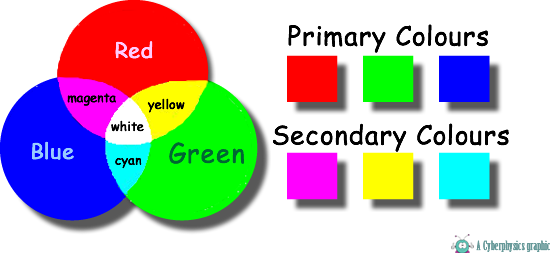Colour Addition If only one set of cones in your eye is stimulated by a colour of light we say that the colour is a primary colour. There are three primary colours of light for us humans because we have three different types colour cone cells on our retina. Other animals have different numbers of primary colours because their eyes have a different number of types of cone cell that detect different ranges of the electromagnetic spectrum. The human eye has three different types of 'cone' on the retina: red, blue and green.
If only two of the sets of cones are activated we call the colour we see a secondary colour.
Overlapping primary light sources stimulate the cones of both of the colours that overlap - that is why we then see the secondary colours of light at the overlap - two sets are stimulated - secondary. Where there is no overlap we see a primary colour - one set of cones stimulated... and where all three overlap we see white light because all of our cones are activated.
Links:
Questions
|
Follow me...
|







